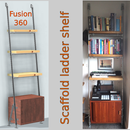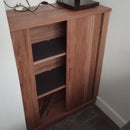Introduction: Railway Sleeper TV Unit
My cousin got in touch with me to ask if I could make him a TV unit as he was just about to buy one off ebay. He sent me a link to the one he wanted and it looked easy enough to do so I went ahead and made it. This one is made out of new solid oak sleepers and an oak board I got from the same place. It's extremely heavy so I have made it to come apart easily to transport it and so it can be moved easier in the future if he ever wants to move it.
Materials
3 No. oak sleepers 200mm x 100mm x 1200mm (8" x 4" x 48")
1 No. oak board 200mm x 38mm x 2500mm (8" x 1.5" x 100")
Threaded rod 12mm x 400mm
Biscuits
Glue
Tools
Table saw or Circular saw, I used both but if I were to do it again I'd probably just use the circular saw.
Router
Drill and drill bits
Sander - I used a belt sander and ROS
Planer thicknesser - depending on how warped your board is and how rustic you want the end result.
Step 1: Prep the Sleepers
I collected the sleepers from a yard that specialises in reclamation and sleepers. As they are kept outside and we had just a weeks of rain and snow they were quite wet on the outside, so I left them to surface dry for a few days before doing anything else. As they are green wood and not completely dried I wasn't too fussed about leaving them too long to dry as they will be drying for the next couple of years. They will of course crack and move about but this will just add character to the TV unit.
Just a quick note on sleepers - the ones I bought are new and have not been previously used on the railways. A lot of the older sleepers were treated with creosote and tar so would not be suitable or safe for indoor furniture, they can be used outside though but only if they aren't going to be touched a lot by children or used for raised beds to grow veggies in!
Once they had dried a bit I cut them to length...which is easier said than done. They are very heavy and 100mm thick, my table saw cuts to a maximum of 55mm so I had to do each one in two passes, turning them over to complete the cut. I ended up with two pieces 800mm long (for the top) and four pieces around 400mm long (for the legs).
Step 2: Join and Sand Sleepers
I next needed to join the pieces to make the legs and top 400mm wide. I thought quite a bit about this as I am not too sure how well glue will perform when joining green timber together. In the end, rightly or wrongly, to join them together with biscuits and glue. I used a biscuit router bit to cut full length grooves in the top and bottom of the timbers used a combination of biscuits and thin slices of beech I cut to fit (making sure the grain of the wood was running perpendicular to the joint). The two timbers were quite difficult to line up and clamp together but once they were they were very difficult to pull apart and move with relation to each other (unclamped) so was quite happy with the method. I'm not too sure about the longevity of the joints but will be able to fix them if they ever do shift about.
On the top part the two timbers weren't quite flush at the ends, but too far out to sand flush, so I thought I'd trim with the table saw. I started to place the timber on my sliding table extension but the weight was too much and I could see that the extension was bending so I abandoned that method. I changed to a circular saw with a piece of laminate flooring for a guide, turning the timbers over to complete the 100mm deep cut.
I then sanded all the parts with a belt sander with 40 grit paper. I then switched to a random orbital sander with 100, 180 and 240 grit paper.
Step 3: Add Fixings, Shelves and Finish
To fix the legs to the top I didn't want a fixed joint as the unit would be far too heavy, so I decided to use 100mm dowels which would keep the legs in the right place with the top and minimise racking. I marked out and drilled some 12mm holes in the legs and top to drop in some 12mm threaded bar I cut to length with a hacksaw.
I also needed to create some shelves but I didn't get round to taking many pictures but the process was as the top and the legs, joined together with glue and biscuit joints.
To attach the shelves to the unit I wanted the fixings to be hidden so I decided to drill and place some hardwood dowels in to the insides of the legs, and routed some corresponding grooves in to the underside of the shelves. These can then simply be places on top on the dowels and easily removed when needed.
Lastly I applied 2 coats of finishing oil on all the parts rubbing with steel wool between coats.

Participated in the
Full Spectrum Laser Contest 2016

Participated in the
Before and After Contest 2016

Participated in the
Homemade Gifts Contest 2015













